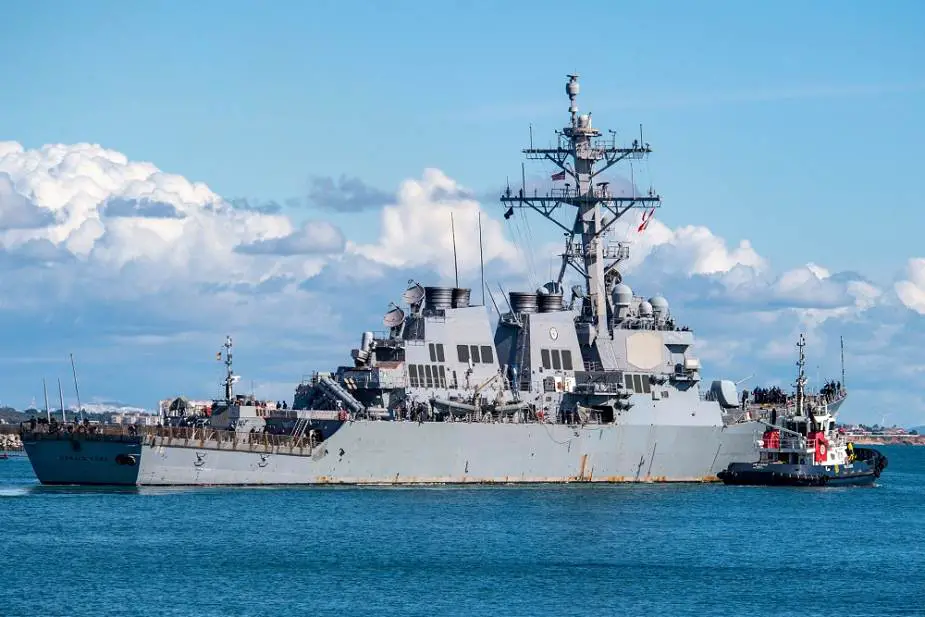Breaking news
US Navy USS Donald Cook DDG 75 destroyer completes air defense exercise with Italian Navy.
According to information published by the U.S. Navy on November 4, 2020, the U.S. Navy The Arleigh Burke-class guided-missile destroyer USS Donald Cook (DDG 75) successfully completed an Air Defense Exercise (ADEX) with an Italian naval air squadron, Nov. 4, 2020.
Follow Navy Recognition on Google News at this link
 U.S. Navy Arleigh Burke-class guided-missile destroyer USS Donald Cook (DDG 75) gets underway for a regularly scheduled deployment, March 22, 2020.(Picture source U.S. Navy)
U.S. Navy Arleigh Burke-class guided-missile destroyer USS Donald Cook (DDG 75) gets underway for a regularly scheduled deployment, March 22, 2020.(Picture source U.S. Navy)
In the Gulf of Taranto, Donald Cook rendezvoused with four Italian AV-8B Harrier II Plus fighter and attack aircraft based in NAS Sigonella, Italy. Air Intercept Controllers onboard the ship took tactical control of two Italian fighter aircraft and directed their employment against hostile aircraft simulated by the other two fighters. The air-to-air training exercise provided realistic training in combining maritime and air assets to achieve a common mission.
The AV-8B Harrier II is a single-engine ground-attack aircraft that constitutes the second generation of the Harrier Jump Jet family. Capable of vertical or short takeoff and landing (V/STOL), the aircraft was designed in the late 1970s as an Anglo-American development of the British Hawker Siddeley Harrier, the first operational V/STOL aircraft. Currently, the Italian Navy has a total of 14 AV-8B Harrier that will be replaced in the future by F-35B.
The U.S. Navy maintains an incredibly close relationship with Italy. U.S. Sixth Fleet, headquartered in Naples, Italy, conducts the full spectrum of joint and naval operations, often in concert with joint, allied, and interagency partners in order to advance U.S. national interests and security and stability in Europe and Africa. Commander, Task Force 67, stationed at Naval Air Station, Sigonella, Italy, executes the maritime patrol and reconnaissance mission with P8-A Poseidon aircraft. The Sixth Fleet flag ship, Blue Ridge-class amphibious command ship USS Mount Whitney (LCC20), forward deploys from Gaeta, Italy. The U.S. Navy’s partnership with Italy enables a dynamic, flexible force posture to execute maritime missions in support Allies and partners.
Donald Cook recently began its eleventh patrol of the U.S. Sixth Fleet area of responsibility in support of U.S. national security interests in Europe and Africa. The ship typically operates independently, but also regularly works alongside NATO allies and partners in the region, as in the case of today’s ADEX.
Donald Cook is one of four U.S. Navy destroyers based in Rota, Spain, and assigned to Commander, Task Force 65 in support of NATO’s Integrated Air Missile Defense architecture. In support of Sixth Fleet, these Forward-Deployed Naval Forces-Europe ships have the flexibility to operate throughout the waters of Europe and Africa, from the Cape of Good Hope to the Arctic Circle, demonstrating their mastery of the maritime domain.
The USS Donald Cook (DDG-75) is an Arleigh Burke-class guided missile destroyer in service with the United States Navy. This ship is the 25th destroyer of her class. USS Donald Cook was the 14th ship of this class to be built at Bath Iron Works in Bath, Maine, where construction began on 9 July 1996. She was launched and christened on 3 May 1997. On 4 December 1998 she was commissioned at Penn’s Landing Pier in Philadelphia, Pennsylvania.
The Arleigh Burke-class destroyers are equipped with Aegis combat system that integrates the ship’s sensors and weapon systems to engage anti-ship missile threats. The Aegis Combat System is an American integrated naval weapons system developed by the Missile and Surface Radar Division of RCA, and now produced by Lockheed Martin. It uses powerful computer and radar technology to track and guide weapons to destroy enemy targets.
The Arleigh Burke-class destroyers are powered by four General Electric LM2500-30 gas turbines, each rated at 33,600 hp with a power turbine speed of 3,600 rpm, driving two shafts with controllable pitch propellers. She can reach a top speed of 30 knots (56 km/h; 35 mph) and has a cruising range of 4,400 nautical miles at 20 knots (8,100 km at 37 km/h). The ship has a crew of 281 people including 33 commissioned officers, 38 chief petty officers, and 210 sailors.




























